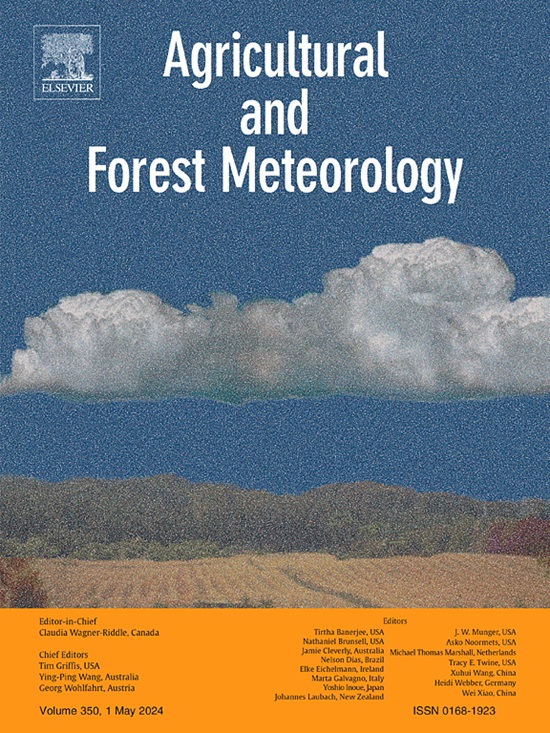通过考虑黄河源区冻结期和解冻期的差异,利用 SMAP SSM 生成高分辨率(1 公里)地表土壤水分
IF 5.6
1区 农林科学
Q1 AGRONOMY
引用次数: 0
摘要
土壤水分(SM)是地表水文循环的重要组成部分,对水文学、气象学和农业等各个领域都有重大影响。准确的高分辨率土壤水分数据对于有效的洪水预报、水资源管理以及了解寒冷地区的土壤冻融过程至关重要。本研究旨在通过使用随机森林(RF)和多元线性回归(MLR)对黄河源区(SRYR)的 SMAP Level-4 SSM 数据进行降尺度处理,生成 1 km 分辨率的液面 SM(SSM)数据,其更新频率为每天两次。为了获得 SSM 数据,针对三种情景分别设计了 16 种 RF 和 MLR 降尺度方案。在每个降尺度过程中,MLR 和 RF 模型都使用了地表温度(LST)和归一化差异植被指数(NDVI),以及反照率、海拔、叶面积指数(LAI)、土壤质地等其他变量的不同组合。结果表明,在冰冻期,如果辅以 NDVI、LST、反照率、海拔高度、叶面积指数和土壤质地,RF 得出的 SSM 估计结果更优。在解冻期,如果与 NDVI、LST、海拔高度、LAI 和土壤质地搭配使用,MLR 更为有效。在冰冻期,缩小尺度的 SMAP SSM 与原地测量值相比,平均 R、RMSE 和 ubRMSE 分别为 0.76、0.029 m3-m-3 和 0.023 m3-m-3。在解冻期,缩小尺度的 SMAP SSM 与实地测量值之间的平均 R、MAE、RMSE 和 ubRMSE 分别为 0.52、0.057 m3-m-3、0.067 m3-m-3 和 0.054 m3-m-3,而原始 SMAP SSM 的平均 R、MAE、RMSE 和 ubRMSE 分别为 0.45、0.070 m3-m-3、0.083 m3-m-3 和 0.060 m3-m-3。因此,这项研究大大提高了 SMAP SSM 估算的准确性和空间分辨率,突出了其在推进 SRYR 水文研究方面的重要作用。本文章由计算机程序翻译,如有差异,请以英文原文为准。
High resolution (1-km) surface soil moisture generation from SMAP SSM by considering its difference between freezing and thawing periods in the source region of the Yellow River
Soil moisture (SM) is a critical component of the land surface hydrological cycle, significantly impacting various sectors such as hydrology, meteorology, and agriculture. Accurate, high-resolution SM data are essential for effective flood forecasting, water resource management, and understanding the soil freeze-thaw processes in cold regions. This study aims to generate 1 km resolution liquid surface SM (SSM) data with a twice-daily update frequency by downscaling SMAP Level-4 SSM data using random forest (RF) and multiple linear regression (MLR) in the source region of the Yellow River (SRYR), by considering the differences in SM changes between freezing and thawing periods. To obtain the SSM data, 16 downscaling schemes of both RF and MLR were designed for each of the three scenarios. In each downscaling process, both land surface temperature (LST) and normalized difference vegetation index (NDVI) were utilized in MLR and RF models, alongside various combinations of additional variables such as albedo, elevation, leaf area index (LAI), soil texture. Results showed that during the freezing period, RF produced superior SSM estimates when supplemented with NDVI, LST, albedo, elevation, LAI, and soil texture. MLR was more effective during the thawing period when paired with NDVI, LST, elevation, LAI, and soil texture. During the freezing period, the downscaled SMAP SSM exhibited average R, RMSE, ubRMSE of 0.76, 0.029 m3·m-3, and 0.023 m3·m-3, respectively, when compared with in-situ measurements. During the thawing period, the average R, MAE, RMSE, and ubRMSE between the downscaled SMAP SSM and in-situ measurements were 0.52, 0.057 m3·m-3, 0.067 m3·m-3, and 0.054 m3·m-3, respectively, compared to 0.45, 0.070 m3·m-3, 0.083 m3·m-3, and 0.060 m3·m-3 for the original SMAP SSM. Thus, the research significantly enhances both the accuracy and spatial resolution of SMAP SSM estimations, underscoring its vital role in advancing hydrological studies within the SRYR.
求助全文
通过发布文献求助,成功后即可免费获取论文全文。
去求助
来源期刊
CiteScore
10.30
自引率
9.70%
发文量
415
审稿时长
69 days
期刊介绍:
Agricultural and Forest Meteorology is an international journal for the publication of original articles and reviews on the inter-relationship between meteorology, agriculture, forestry, and natural ecosystems. Emphasis is on basic and applied scientific research relevant to practical problems in the field of plant and soil sciences, ecology and biogeochemistry as affected by weather as well as climate variability and change. Theoretical models should be tested against experimental data. Articles must appeal to an international audience. Special issues devoted to single topics are also published.
Typical topics include canopy micrometeorology (e.g. canopy radiation transfer, turbulence near the ground, evapotranspiration, energy balance, fluxes of trace gases), micrometeorological instrumentation (e.g., sensors for trace gases, flux measurement instruments, radiation measurement techniques), aerobiology (e.g. the dispersion of pollen, spores, insects and pesticides), biometeorology (e.g. the effect of weather and climate on plant distribution, crop yield, water-use efficiency, and plant phenology), forest-fire/weather interactions, and feedbacks from vegetation to weather and the climate system.

 求助内容:
求助内容: 应助结果提醒方式:
应助结果提醒方式:


